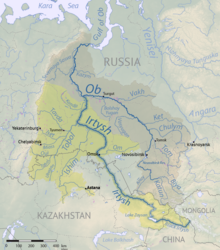| Konda | |
|---|---|
 | |
 The Konda in the Irtysh basin | |
| Location | |
| Country | Russia |
| Region | Khanty-Mansi Autonomous Okrug |
| Physical characteristics | |
| Source | West Siberian Plain |
| • location | Sovetsky District |
| • coordinates | 61°26′49″N 64°29′53″E / 61.447°N 64.498°E |
| • elevation | 123 m (404 ft) |
| Mouth | Irtysh |
• location | Tiuli, Khanty-Mansiysky District |
• coordinates | 60°42′23″N 69°40′13″E / 60.7064°N 69.6703°E |
• elevation | 20 m (66 ft) |
| Length | 1,097 km (682 mi) |
| Basin size | 72,800 km2 (28,100 sq mi) |
| Basin features | |
| Progression | Irtysh→ Ob→ Kara Sea |
| Tributaries | |
| • left | Mulymya, Bolshoy Tap, Yukonda, Kama[1] |
| • right | Yevra, Kuma[1] |
The Konda (Russian: Конда) is a river in the Khanty–Mansia region of Russia. The town of Uray and the Shaimskoye oil field are along the Konda.[1]
It is a left tributary of the Irtysh. It is 1,097 kilometres (682 mi) long with a drainage basin of 72,800 square kilometres (28,100 sq mi).[2] The river has its sources on the western edge of the West Siberian Plain. The average discharge 164 kilometres (102 mi) from its mouth is 231 cubic metres per second (8,200 cu ft/s), with a maximum of 1,220 cubic metres per second (43,000 cu ft/s) and a minimum of 36.1 cubic metres per second (1,270 cu ft/s). The river is frozen over from late October to late April. Its main tributaries are from the left: Mulymya, Bolshoy Tap, Yukonda and Kama, and from the right: Yevra and Kuma.[1]
The Konda region, or Kondia, is one of the many provinces mentioned in the full official title of Russian tsars.
References
[edit]- ^ a b c d Конда, Great Soviet Encyclopedia online (in Russian)
- ^ "Река КОНДА in the State Water Register of Russia". textual.ru (in Russian).
Well, that’s interesting to know that Psilotum nudum are known as whisk ferns. Psilotum nudum is the commoner species of the two. While the P. flaccidum is a rare species and is found in the tropical islands. Both the species are usually epiphytic in habit and grow upon tree ferns. These species may also be terrestrial and grow in humus or in the crevices of the rocks.
View the detailed Guide of Psilotum nudum: Detailed Study Of Psilotum Nudum (Whisk Fern), Classification, Anatomy, Reproduction